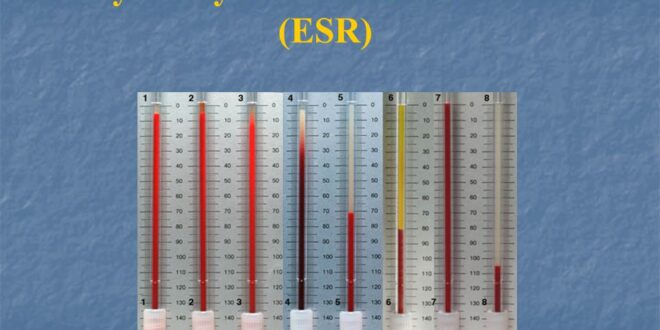ESR Westergren is a blood test that measures the erythrocyte sedimentation rate (ESR), which is the rate at which red blood cells settle in a tube of blood over a certain period of time. The test is named after its developers, Swedish hematologist Robert Westergren and his colleague Åke Åkerlund.
The ESR Westergren test is a non-specific measure of inflammation in the body. When there is inflammation or infection present, certain proteins in the blood can cause the red blood cells to clump together, which can increase the rate at which they settle to the bottom of the tube. A higher ESR indicates a higher degree of inflammation or infection in the body.
The ESR Westergren test is commonly used to help diagnose and monitor the progress of inflammatory conditions such as rheumatoid arthritis, systemic lupus erythematosus, and temporal arteritis. It can also be used to monitor the progress of certain infections, such as tuberculosis.
It’s important to note that while the ESR Westergren test can be a useful tool in diagnosing and monitoring certain conditions, it is not specific to any one disease or condition. Other tests and diagnostic tools, such as imaging tests or specific blood tests, may be necessary to confirm a diagnosis or monitor the progress of a disease.
In general, iron deficiency does not typically cause a high ESR Westergren. Instead, a high ESR Westergren is often associated with inflammation or infection.
However, certain conditions can cause both iron deficiency and an elevated ESR Westergren. For example, chronic kidney disease, which can lead to iron deficiency anemia, can also cause an elevated ESR due to the presence of inflammation in the body. Similarly, some types of cancer, such as lymphoma or multiple myeloma, can cause both iron deficiency and an elevated ESR.
It’s important to note that the ESR Westergren test is a non-specific measure of inflammation, and a high result can be caused by a wide range of conditions. Therefore, if you have a high ESR Westergren, your doctor may need to perform further tests to determine the underlying cause.
High ESR
If you have a high ESR Westergren, your doctor may perform additional tests to determine the underlying cause. The specific tests ordered will depend on your symptoms and medical history, but some of the tests that may be recommended include:
- Complete blood count (CBC): A CBC measures the number and types of cells in your blood, including red blood cells, white blood cells, and platelets. This test can help identify anemia or other blood disorders.
- C-reactive protein (CRP): Like ESR, CRP is a marker of inflammation in the body. If CRP is also elevated, it can help confirm the presence of inflammation and may help identify the underlying cause.
- Ferritin: Ferritin is a protein that stores iron in the body. Low levels of ferritin are often seen in iron deficiency anemia.
- Blood culture: If your doctor suspects that you have an infection, they may order a blood culture to identify the type of bacteria or other pathogen causing the infection.
- Imaging tests: Depending on your symptoms, your doctor may order imaging tests such as X-rays, CT scans, or MRI scans to evaluate the affected area.
- Biopsy: In some cases, a tissue biopsy may be necessary to confirm a diagnosis. For example, if your doctor suspects cancer, they may perform a biopsy to collect a tissue sample for testing.
These are just a few examples of the tests that your doctor may order to help determine the underlying cause of a high ESR Westergren. Your doctor will work with you to determine the best course of action based on your specific symptoms and medical history.
ESR Westergren high means.
ESR stands for erythrocyte sedimentation rate, which is a measure of the rate at which red blood cells settle to the bottom of a tube in a specific amount of time. The Westergren method is the most commonly used method to measure ESR.
If the ESR Westergren value is high, it indicates that there is an increased level of inflammation or infection in the body. Some conditions that can cause a high ESR Westergren include autoimmune disorders, infections, certain cancers, and chronic inflammatory conditions. However, a high ESR Westergren value alone is not enough to diagnose a specific condition and further tests may be needed to determine the underlying cause. It is important to discuss your ESR Westergren results with your healthcare provider for proper interpretation and management.
Here is a tabular form showing the normal range of ESR (erythrocyte sedimentation rate) using the Westergren method based on age and gender:
| Age/Gender | Normal ESR Westergren Range |
|---|---|
| Male <50 | Less than or equal to 15 mm/hr |
| Female <50 | Less than or equal to 20 mm/hr |
| Male 50-59 | Less than or equal to 20 mm/hr |
| Female 50-59 | Less than or equal to 30 mm/hr |
| Male 60-69 | Less than or equal to 25 mm/hr |
| Female 60-69 | Less than or equal to 35 mm/hr |
| Male 70-79 | Less than or equal to 30 mm/hr |
| Female 70-79 | Less than or equal to 40 mm/hr |
| Male >80 | Less than or equal to 35 mm/hr |
| Female >80 | Less than or equal to 50 mm/hr |
Again, it’s important to note that the ESR Westergren is a nonspecific test and a normal result does not rule out the possibility of an underlying medical condition. Your healthcare provider can help interpret your ESR Westergren results in the context of your overall health and medical history.
High ESR symptoms
ESR (erythrocyte sedimentation rate) is a laboratory test that measures the rate at which red blood cells settle to the bottom of a tube in a specific amount of time. It is a nonspecific test that can be elevated in various conditions.
An elevated ESR alone does not cause any symptoms, but it may be a sign of an underlying medical condition. Some of the conditions that can cause a high ESR to include:
- Infections
- Autoimmune disorders
- Cancer
- Chronic inflammatory conditions such as rheumatoid arthritis, lupus, and inflammatory bowel disease
- Certain medications
The symptoms of these conditions vary depending on the underlying cause. For example, infections may cause symptoms such as fever, chills, cough, and body aches. Autoimmune disorders can cause symptoms such as joint pain, fatigue, and skin rash. Cancer may cause symptoms such as unexplained weight loss, fatigue, and night sweats.
It’s important to note that an elevated ESR is not diagnostic of any specific condition and additional tests may be needed to determine the underlying cause. If you have an elevated ESR or any concerning symptoms, it’s important to talk to your healthcare provider for proper evaluation and management.
What happens if the erythrocyte sedimentation rate is high?
If the erythrocyte sedimentation rate (ESR) is high, it may be an indication of an underlying medical condition. ESR is a laboratory test that measures the rate at which red blood cells settle to the bottom of a tube in a specific amount of time. It is a nonspecific test that can be elevated in various conditions.
Some of the conditions that can cause a high ESR to include:
- Infections
- Autoimmune disorders
- Cancer
- Chronic inflammatory conditions such as rheumatoid arthritis, lupus, and inflammatory bowel disease
- Certain medications
If an underlying condition is present, the treatment will depend on the specific cause. For example, infections may be treated with antibiotics or antiviral medications. Autoimmune disorders may be treated with immunosuppressive medications. Cancer treatment may include surgery, chemotherapy, or radiation therapy.
It’s important to note that an elevated ESR is not diagnostic of any specific condition and additional tests may be needed to determine the underlying cause. If you have an elevated ESR, it’s important to talk to your healthcare provider for proper evaluation and management.
What is the ESR level in cancer patients?
The erythrocyte sedimentation rate (ESR) is a nonspecific laboratory test that measures the rate at which red blood cells settle to the bottom of a tube in a specific amount of time. It can be elevated in various conditions, including cancer.
The ESR level in cancer patients can vary depending on the type and stage of cancer, as well as other factors such as age and comorbidities. In general, some cancers, such as lymphoma and multiple myeloma, are more likely to cause a high ESR than others. However, it’s important to note that an elevated ESR alone is not diagnostic of cancer and further testing is needed to confirm a diagnosis.
In some cases, an elevated ESR may be used to monitor the response to cancer treatment. A decrease in ESR may indicate a response to treatment, while an increase in ESR may indicate disease progression.
It’s important to discuss ESR levels with a healthcare provider, who can interpret the results in the context of a patient’s overall health and medical history. If there are any concerns about cancer or other medical conditions, further testing and evaluation may be needed.
High ESR causes and treatment
The erythrocyte sedimentation rate (ESR) is a nonspecific laboratory test that measures the rate at which red blood cells settle to the bottom of a tube in a specific amount of time. It can be elevated in various conditions, and the treatment will depend on the underlying cause.
Some of the common causes of a high ESR include:
- Infections, such as bacterial or viral infections
- Autoimmune disorders, such as rheumatoid arthritis, lupus, or vasculitis
- Cancer, such as lymphoma or multiple myeloma
- Chronic inflammatory conditions, such as inflammatory bowel disease or chronic obstructive pulmonary disease (COPD)
- Pregnancy
- Certain medications, such as birth control pills or corticosteroids
The treatment for an elevated ESR will depend on the underlying cause. For example, if an infection is present, antibiotics or antiviral medications may be prescribed. Autoimmune disorders may be treated with immunosuppressive medications. Cancer treatment may include surgery, chemotherapy, or radiation therapy. In some cases, a high ESR may not require treatment, especially if there are no other symptoms or indications of an underlying condition.
It’s important to discuss ESR levels with a healthcare provider, who can interpret the results in the context of a patient’s overall health and medical history. Additional tests may be needed to determine the underlying cause of an elevated ESR. If there are any concerns about an underlying condition, prompt evaluation and treatment may be necessary to prevent complications.
Why ESR is high in females?
The erythrocyte sedimentation rate (ESR) is a nonspecific laboratory test that measures the rate at which red blood cells settle to the bottom of a tube in a specific amount of time. It can be elevated in various conditions and is not specific to any particular gender. However, certain factors may cause ESR to be higher in females.
One of the reasons why ESR may be higher in females is related to hormonal changes that occur during menstruation. It’s not uncommon for ESR to be slightly elevated during the menstrual cycle, particularly in the days leading up to menstruation. Additionally, pregnancy can also cause a temporary increase in ESR.
Autoimmune disorders, which are more common in females, are another reason why ESR may be higher in females. Conditions such as rheumatoid arthritis and lupus can cause chronic inflammation, which can result in an elevated ESR.
Lastly, anemia, which is more common in females, can also cause an elevated ESR. Anemia is a condition in which the body doesn’t have enough red blood cells, which can result in an increase in ESR.
It’s important to note that an elevated ESR alone is not diagnostic of any specific condition, and additional testing may be needed to determine the underlying cause. If you have an elevated ESR or any concerning symptoms, it’s important to talk to your healthcare provider for proper evaluation and management.
The erythrocyte sedimentation rate (ESR) is a laboratory test that measures the rate at which red blood cells settle to the bottom of a tube in a specific amount of time. The normal range of ESR can vary depending on a person’s age and gender, as well as the laboratory performing the test. Typically, a normal ESR range is between 0-20 mm/hr for men and 0-30 mm/hr for women.
An ESR of 40 mm/hr may be considered high, as it is above the normal range for both men and women. However, it’s important to note that an elevated ESR alone is not diagnostic of any specific condition, and additional testing may be needed to determine the underlying cause. The specific range considered high may vary depending on the laboratory reference range, and your healthcare provider will consider your individual medical history, symptoms, and other test results when interpreting your ESR levels.
If you have an elevated ESR or any concerning symptoms, it’s important to talk to your healthcare provider for proper evaluation and management.
 Shalkot The Innovators
Shalkot The Innovators




